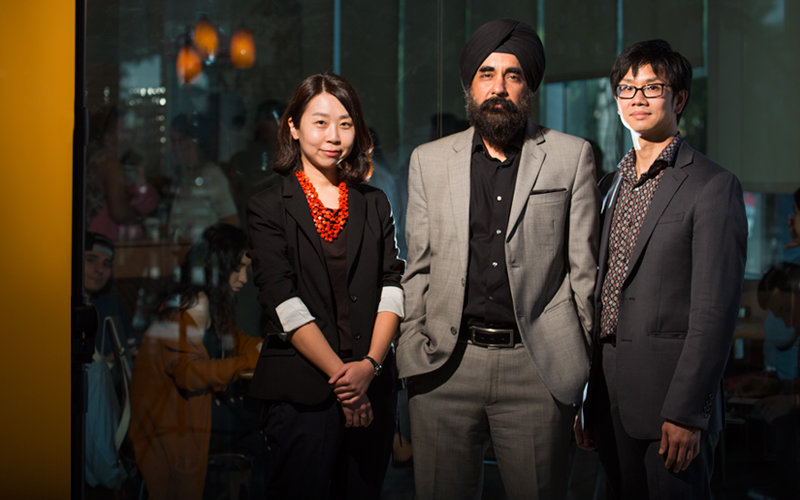
What happens when you get three marketing professors together to discuss globalization, cultural branding and marketing? You not only get a solid scholarly journal article but also one of the most unusual headlines for an academic article.
“A Korean, a Chinese and an Indian Walk Into an American Bar: Tapping the Asian-American Goldmine,” written by CSUF marketing faculty members Steven Chen, Yuna Kim and Chiranjeev Kohli, studied the growth of small global brands, like 99 Ranch Markets and KakaoTalk, and discovered the changes they are bringing about in the branded marketplace. The results of their study were published in the January-February issue of Business Horizons.
What prompted the three academics — indeed a Korean, a Chinese and an Indian — to do the study? Chen says the motivation was personal.
“When I was young, my mother would take me grocery shopping at the 99 Ranch Market, a Chinese-heritage supermarket, and that market never really ‘spoke’ to me since I was born in the U.S. and I did not read Chinese,” he explained. “But now, 99 Ranch Market is a very different place. The chain sells all sorts of products — not just traditional Chinese ones. And non-Chinese customers are common. So thinking about the shift in 99 Ranch’s marketing strategy in the last two decades got me thinking about how Asian businesses can grow their business through ethnic marketing.”
“Similar to Steven, it was a personal experience that got me interested in this topic,” said Kim. “The first example used in the article, KakaoTalk, is an instant messaging platform created for/by and used by Koreans.
“Being Korean myself, I used it and all of my friends and family used it,” Kim said. “However I was surprised one day to find one of my non-Korean friends using it. When asked how she knew about the platform, she told me that one of her close Korean friends introduced it to her.
“I continued to experience similar instances where I found non-Koreans consuming products, services and content that were created specifically for a Korean audience,” added Kim.
Kohli, who is older, remembers not even seeing any Indian brands when he came to the U.S. in 1987. “But like Steven and Yuna, I have also seen an increasing presence of Asian brands.”
Kim and Chen shared their experiences and decided to conduct research to find out the underlying reason for the phenomenon. Both scholars did background research on bicultural marketing, as well as “mini-case studies on Asian brands that entered the U.S. market,” explained Chen.
“I knew advances in technology or the increasing use of social media was changing the business landscape, but what was interesting to me in this case was that the companies weren’t even trying to reach out to new consumers,” explained Kim. “Technology itself was getting rid of the barriers.”
Through their work they discovered differences in consumer behavior, not so much between Asian and non-Asian but generationally, as well as between the different Asian cultures.
“The catchphrase ‘Asian-American’ alludes to the idea that all Asian-Americans are similar. But this is not the case,” said Chen. “What struck me was how consumer behavior differed based on generational differences — first- vs. second-generation Asian-Americans.
“And within those differences lie tremendous marketing segmentation opportunities,” Chen noted.
While Chen and Kim focused on the expansion of Asian products, Kohli explored how such brands are being marketed and what the differences mean to branding overall. Kohli, a comedian by avocation, also contributed the edgy headline.
The difference in generational marketing — and in branding — echoed what Kohli found in an earlier study he conducted (“Will Social Media Kill Branding?”). “And one of the conclusions of that paper was that the marketplace will be disrupted more often by new entrants. So findings from that paper neatly bolstered the argument we were making in this paper.”
Kohli, Chen and Kim all agree that the trends they found in their research are bound to continue.
“We’re entering a marketplace that will be a lot more dynamic and exciting, as well as nerve wracking for established players,” said Kohli. “Everyone will have to remain on their toes.”
“Asian-Americans are the fastest growing ethnic segment in the U.S., so I do see these trends continuing and being magnified in the future,” agreed Chen. “I think the industry has got it all wrong though. Many advertisers seek a ‘total marketing approach’ to capture all Asian-Americans in one marketing campaign. This study suggests that a ‘total marketing approach’ is one possible strategy, but not likely to be a very successful one. Our paper offers several different alternatives.”